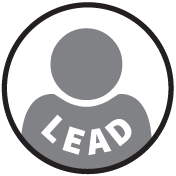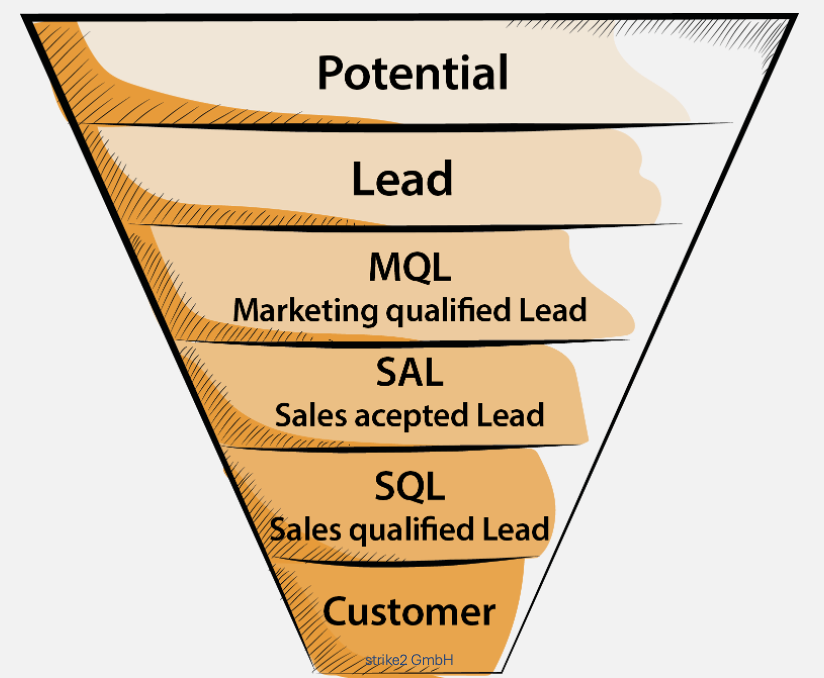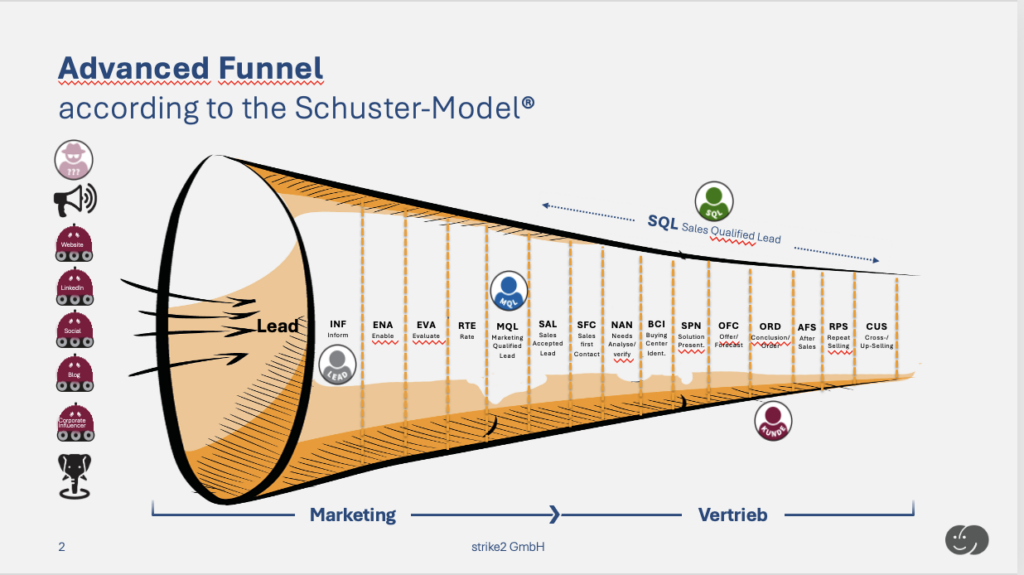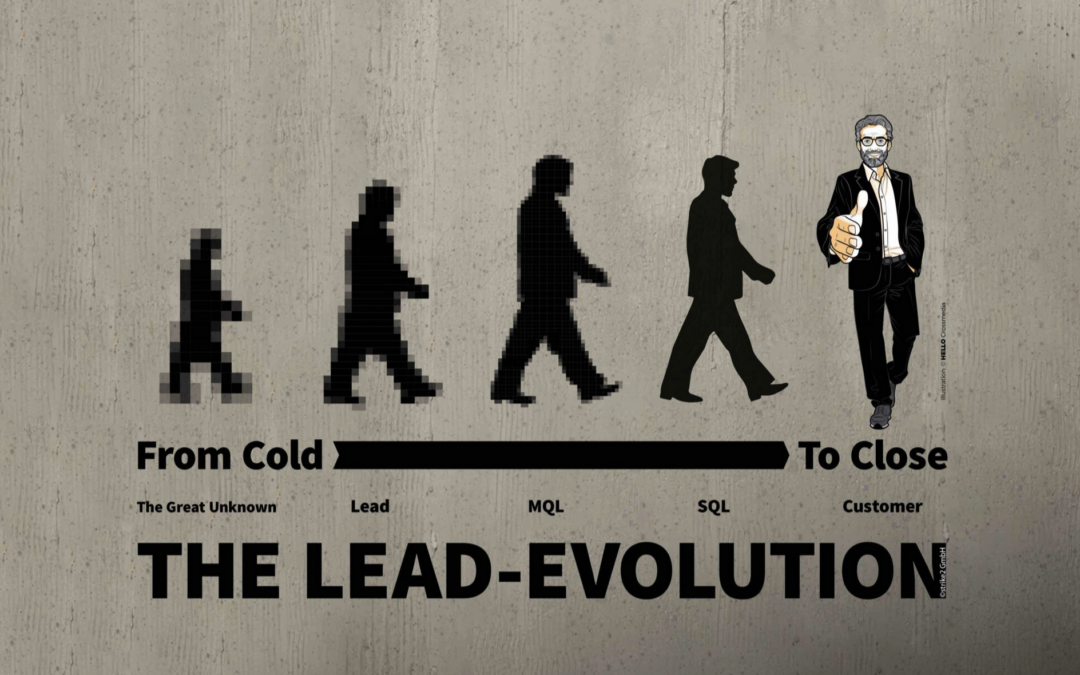My claim ‘from cold to close®’ describes the development of a lead (#LeadEvolution) over several stages from the ‘raw lead’ (‘Cold’) via the status MQL (marketing qualified lead) to the status ‘customer’ (‘Close’). The ‘Close’ stands for close, i.e. one has approached, got to know each other and at the same time ‘Close’ also stands for ‘Closing the Deal’.
The stages:
‘The Great unknown’LeadMQLSALSQLCustomer

The Great unknown
It starts with ‘the great unknown’ – the great unknown prospect
In other words, the phase in which companies have not yet defined and profiled the ideal lead. Any leads that arrive at the company anyway may or may not be a good fit. And the sales department has to go to great lengths to qualify these leads in order to recognise the sales opportunities. It is also the anonymous lead that has not yet made itself known. The image of this lead is very ‘pixelated’ and blurred.

The Lead
Lead / enquiry
If a lead identifies itself, the picture becomes a little clearer. We know where the lead comes from, what they are interested in and can respond. However, we still can’t say much more about this lead as we usually don’t have the relevant information at this stage. If we ask for too much information in the first form, this usually worsens the conversion rate. With ‘progressive profiling’, we make do with just a little information such as email, opt-in, title and name in this phase. In the subsequent stages, we ask for more and enrich the profile. Assessments based on the e-mail address are not particularly useful, as anything from a working student to a board member can be hidden behind an address. And even if it is the decision-maker, he/she is usually not yet ready for sales contact at this stage. If a lead asks for advice, they are of course forwarded to sales and sales can qualify them. You can find out more about the sales fast lane in this article: https://from-cold-to-close.com/the-sales-fast-lane-in-the-digital-sales-process/

If the lead only consumes one piece of content (whitepaper, application note, checklist, etc.), it is usually not yet mature enough to be handed over to sales. The ‘green banana effect’ kicks in. You can find out more about the green banana effect here: https://from-cold-to-close.com/the-green-banana-effect-in-marketing-and-sales/
These leads should be developed with automated lead nurturing processes until they are ready for sales, i.e. MQL status. Marketing and sales jointly define when a lead reaches the ‘MQL’ stage. A lead that contacts you without having gone through a nurturing process is not an MQL because it has not yet been qualified.

The MQL
MQL – marketing qualified lead
Once the MQL stage defined by Marketing and Sales has been reached, the lead is offered to Sales. At this stage, sales is also transferred from the marketing automation platform to the CRM system. This transfer is ideally realised with a no-coding iPaaS platform (Integration Platform as a Service).
If your CRM system uses the ‘Lead’ entity, the lead is stored there and the sales department is informed that a new lead has arrived.

The SAL
The sales department can reject this lead. There should be a good reason for the rejection. If the number of rejected SALs is too high, the reasons for this should be discussed. Possible reasons could be
The buyer persona was incorrectly selected or not profiled in sufficient detail.The buyer persona profiles have not been verified.The approach attracts the wrong / suboptimal leads.Approach and content modules do not match.The nurturing process does not filter out the wrong / non-optimal leads.
If the sales department accepts the lead, it makes the initial contact and checks whether there is a sales opportunity.

The SQL
SQL – Sales qualified lead
If a sales opportunity exists, the lead is converted and created as an account (company), contact (contact person) and opportunity (sales opportunity) in the CRM system. The SQL stage is reached. In complex B2B sales, this status can also extend over several stages and activities:
SFC - Sales first contactThe sales department has analysed the history of the prospective or existing customer and prepared the appropriate approach and arguments. This establishes the initial contact.- N
AN - Needs analysisDuring the initial contact or at a later point in time, the sales department analyses the needs of the (potential) customer. BCI - Identify buying centreIf the decision is not made by the lead approached, but by another person or a purchasing committee, the sales department gains an overview of the buying centre and the decision-making processes in the company in this phase. This will not be a separate stage in all sales organisations, but in some sales organisations this stage can also extend over a longer period of time.SPN - Solution presentationThe sales department presents the solution or solution variants that meet the requirements. This process will also be omitted in some sales organisations, as a simple offer may already be presented during the initial contact.- OFC
- Offer/OpportunityIf the sales department recognises a sales opportunity, it creates an opportunity and may also create a corresponding offer. - ORD
- Closing/orderThis phase is about taking all the steps that lead to the signing of a contract/order.

The Customer
AFS – After-Sales
The customer has decided to buy a system, for example. What happens after the signature? How is the system implemented at the customer’s premises? What does the customer need to operate the system? At this stage, digital processes help to sell service, maintenance, training or consumables to the customer.
RPS – repurchase / repeat selling
If the customer has bought a system, machine or module, they could use the same thing several times. Ideally, a new system will also be utilised again at some point. A digital process helps the sales department to sell the same ‘package’ again.
CUS – cross-selling and up-selling
Irrespective of the repurchase of an already purchased system, the customer may also need to supplement the system or purchase a larger system or another product. For this purpose, you can also create digital processes with the appropriate approaches and content offers.

strike2 Advanced Funnel
These stages in the buying process are of course just a suggestion. You don’t have to map your funnel in such detail. Depending on the customer structure and purchase process, it can also be simpler.
However, this ‘advanced funnel’ is very helpful in optimising the approach, content modules and processes. It helps to find and plug the ‘holes in the funnel’. It also supports the planning and decision-making phase, as it promotes the following insights:
Which approach worked?Which touchpoint delivered which results?How many leads were generated?How many leads are currently in which stage?How good is the conversion from stage to stage?How many MQLs were offered to sales and how many were accepted as SAL?Which leads are in which stage of sales support?What is the flow rate of the leads?How many leads have come to sales via sales fast lane at which stage of their purchase process?...
Conclusion:
In modern lead management, we avoid the ‘green banana effect’ and develop ‘raw leads’ with relevant content modules that match the stage of their customer journey until they are ready for sales (MQL marketing qualified leads). Optionally, you can use the sales fast lane to establish direct contact with sales at every stage. Regardless of which option the leads choose, they move ‘from cold to close®’.


